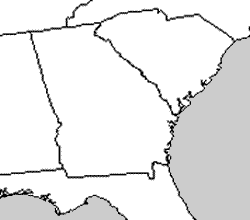Kemp’s Ridley Sea Turtle (Lepidochelys kempii)

Photos by J.D. Willson unless otherwise noted
Description: Kemp’s ridley sea turtles, the smallest of the marine turtles, have a carapace length of 52-75 cm (20.3-29.3 in) and weigh 36-45 kg (80-100 lb). The carapace is unique in that it is rounded and flattened, with a distinct keel running down the midline. The color of both carapace and flippers is gray to olive green on top. The first costal scute on each side of the turtle is reduced and touches the nuchal scute. There are five costal scutes in total. Kemp’s ridleys also have four bridge scutes, each of which contains a noticeable pore. The large scutes of the carapace overlap. Each flipper has one claw.
Distribution and Habitat: While Kemp’s ridleys can be found in the western Atlantic as far north as southern New England and as far south as southern Brazil, they are confined mostly to the Gulf of Mexico. They nest almost exclusively in one location. Every year females lay their eggs on a beach near Rancho Nuevo in Tamaulipas, Mexico. Nesting does occasionally occur in other places on the Gulf coasts of Mexico and Texas. Juveniles search for food in the shallow waters around estuaries, river mouths, bays, and lagoons from New England to Georgia. Adults prefer muddy or sandy benthic environments where their favorite foods, crustaceans and mollusks, are abundant.
Reproduction and Development: Egg laying in this species is synchronized. Presumably to reduce predation risk, thousands of females come ashore to nest, all within the span of a few days. This phenomenon, known as arribada (Spanish for “arrival”) occurs from April to August at intervals of about 28 days. Not only do females nest at the same time, but they also nest during the day, which does not typically occur in any other species of sea turtle. The average clutch size is 110 eggs, and females typically lay up to four clutches per year. There has been some concern over a recent decrease in clutch size, but it is speculated that this is due to a higher number of novice nesters in response to conservation efforts. The incubation period is 45-58 days. Sex is temperature dependent; warmer temperatures yield a higher number of females.
Habits: The diet of Kemp’s ridleys is highly varied. Juveniles feed on seaweed, pelagic crabs, and mollusks at the surface. At a length of around 20 cm (7.8 in), crabs and mollusks on the ocean floor become the preferred food source. Adults have very few predators. As is the case with most sea turtles, sharks and humans present the most danger. Hatchlings are defenseless and are eaten by a diversity of predators.
Conservation: Listed as critically endangered by the IUCN, Kemp’s ridley sea turtles are the rarest of all the sea turtles. Their tradition of day nesting may have evolved under the philosophy of protection in numbers, but this conspicuous behavior makes them easy targets for humans and other mammals. Fortunately, recent conservation efforts by Mexico and the United States have caused the population size to increase. The use of Turtle Exclusion Devices (TEDs) is essential for the survival of this species.
Pertinent References:
Conant, R., and J. T. Collins. A Field Guide to Reptiles & Amphibians: Eastern and Central North America. 3rd ed. Boston: Houghton Mifflin, 1998.
Gulko, D., and K. Eckert. Sea Turtles: An Ecological Guide. Honolulu: Mutual, 2004.
Jensen, J. B., C. D. Camp, W. Gibbons, and M. J. Elliott. Amphibians and Reptiles of Georgia. Athens: University of Georgia, 2008.
Account Author: Lindsay Partymiller
